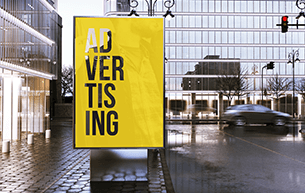How could billboard advertising help your business succeed?

As many of us our aware, advertising is all about grabbing a person’s attention and encouraging them to follow through on an action. Arguably, one of the most effective methods of making someone pay attention is with a large billboard placed strategically in a public place.
It is thought that the billboard originated in New York around the mid-1830s, with the earliest record of a leased billboard space being documented in 1867. However, since then, this form of print marketing has become a staple of advertising and has even played a part on the silver screen as a crucial prop in recent blockbuster, Three Billboards Outside Ebbing, Missouri.
And, if you’re looking to maximise your marketing ROI, a billboard is certainly worth considering. If you’re not convinced, find out why billboard advertising might be the boost your brand needs…
The power of a billboard
In statistics gathered by Route, the average Brit was found to be ‘out and about’ for three hours and ten minutes every day, spending around 16 minutes in the view of advertisements. Why not target your consumer during this window of opportunity with a large, quality, well-located billboard in a place with high footfall or traffic?
Don’t let time constraints put you off either. Another reason that billboards are an excellent option for marketing a product or service is that they’re simple to design and print — no putting together multiple pages in a brochure. Need something effective up and running in a hurry? A billboard is a single page of design, which should save you time when putting together a template that will offer maximum ROI.
Take the ‘Marketing Rule of 7’ as inspiration. By placing an outdoor banner in a public place where people will pass every day or a few times a day — like on the way to work or when dropping off and picking up their kids from school — you can help hit this number and potentially increase your brand’s chances of a conversion.
It’s clear to see that billboard advertising could be a beneficial branch of your wider marketing campaign. So, how do you make sure your billboards are as effective as possible?
How to design a successful billboard
We all know that the best adverts are eye-catching. However, if your billboard will be placed at the side of a high-speed road, this creates an even greater demand for noticeability. Think strategically about what you want on your billboard — someone driving past at 40mph is only going to be able to take in so much. What is your marketing objective? Do you want to sell a specific product? Are you spreading brand awareness? Promoting an event? Determine exactly what you want to achieve from your advertisement and provide only the essential information — like contact number, name of product or date and location of event.
An advantage of a billboard is that it’s the ideal platform for a big, conceptual image — which can work wonders from a marketing perspective. According to research, people generally only recall 10% of information they hear three days later. However, using a relevant image alongside this information increases retention by 55%. When designing your billboard, try and think of a funny or quirky image that will grab and hold a passer-by’s attention — such as cake brand, Mr Kipling’s, clever and unusual image of a bunny made using only Cherry Bakewell cakes as part of its Easter marketing campaign. Due to the size of a billboard, your images can pack a more powerful punch, so focus on getting the image perfect and then build your design from there.
Another thing to bear in mind is clarity, especially if you want people to not only notice your billboard but also consume the information on it. Utilise bright and bold colours to catch the eye — contrasting colours are reportedly stay in people’s memories for longer, too — and opt for a simple background and large, readable text — Sans Serif is a good shout.
Consider the placement of your billboard too, is it going to be on a roadside? A driver typically has five to ten seconds to view an ad, which means you need to consider copy length. The more relevant and informative your image is, the less you should need to convey with text — stick to a brief, punchy message of seven words and you should get your marketing message across, no problem.
Think about your target audience when selecting the location too. For example, if your products are for 18-21-years-olds, find a site near a university or college. Otherwise, you could reduce your ROI due to not being in sight of the people who are most likely to engage and act on your ad.
Creating a local campaign? Why not create a stronger connection with the residents by including something that references the town or city? Include an image of a local landmark to create a sense of familiarity or reference the local traffic in a funny way. Humour generally works in advertising. According to a review of 6,500 ads, the funniest were usually cited as being the most appealing and memorable. What’s more, adopting this personal and familiar approach creates a sense of friendliness, so you’ll also exude a more welcoming brand persona — which will be more encouraging to a potential customer.
As we can see, billboard marketing is an excellent way to drive a successful marketing campaign — try it at your business and start increasing sales and customers!
This article was created by Where The Trade Buys, service providers of foam board printing.








